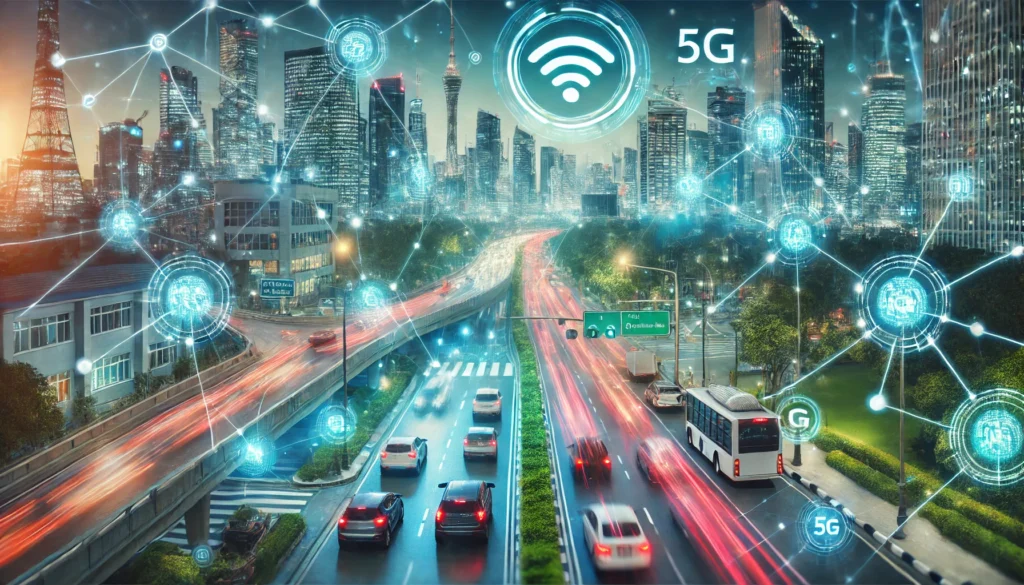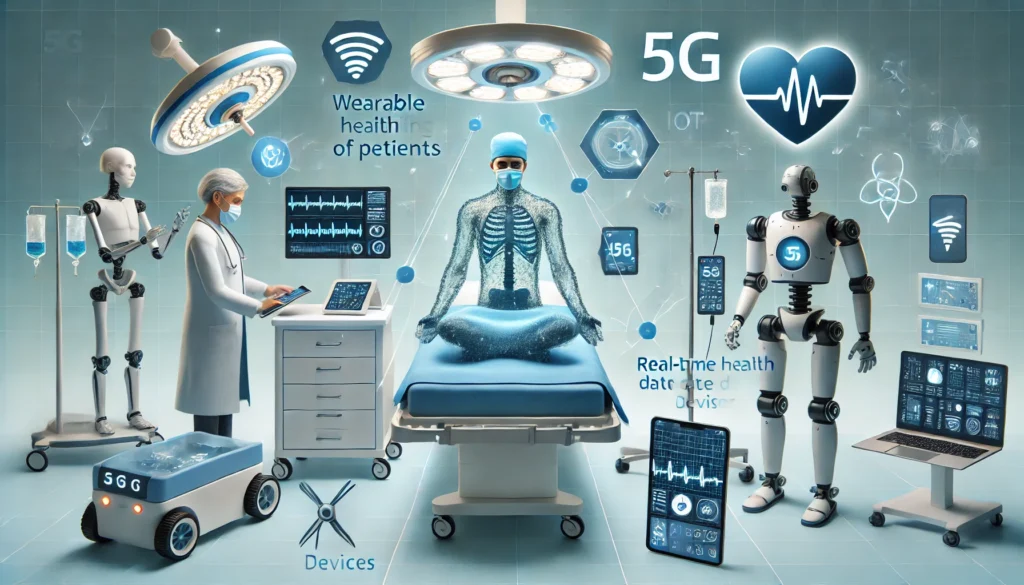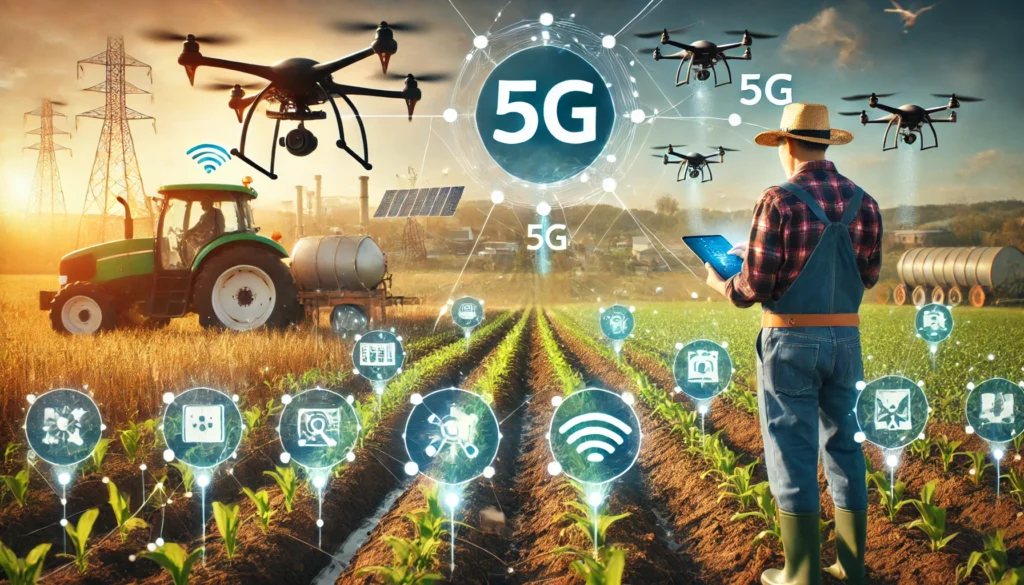Introduction
The world is on the brink of a technological revolution with the advent of 5G technology. This new generation of wireless technology promises to transform how we connect and interact with the world around us. At the same time, the Internet of Things (IoT) is expanding, connecting billions of devices globally. The synergy between 5G and IoT is set to unlock unprecedented possibilities. This blog will explore how 5G technology enhances IoT, making our lives more innovative, efficient, and connected. Let’s see How Does 5G Technology Enhance the Internet of Things IoT

Table of Contents
Understanding 5G Technology
Definition and Key Features of 5G
5G, or fifth-generation wireless technology, is the latest advancement in mobile networks. It offers significantly higher speeds, lower latency, and greater capacity than its predecessor, 4G. Key features of 5G include enhanced mobile broadband, ultra-reliable low-latency communication, and massive machine-type communications.
Differences Between 4G and 5G
While 4G laid the groundwork for mobile internet, 5G takes it to a new level. 5G is 100 times faster than 4G, enabling instantaneous data transfer. Latency, the delay before a data transfer begins, is reduced to a few milliseconds, making real-time communication a reality. Additionally, 5G can handle many connected devices simultaneously, which is crucial for expanding IoT.
The Potential of 5G in Transforming Connectivity
5G’s potential extends beyond faster internet speeds. It is set to revolutionize industries by providing the infrastructure for advanced technologies like autonomous vehicles, remote surgery, and smart cities. 5 G’s high reliability and low latency are essential for applications that require real-time responses and stable connections.
The Internet of Things (IoT) Overview
Definition and Scope of IoT
The Internet of Things refers to the network of interconnected devices that communicate and exchange data. These devices range from everyday household items like refrigerators and thermostats to complex industrial machinery. IoT enables these devices to collect and share data, automate processes, and provide valuable insights.
Examples of IoT Applications in Various Industries
IoT has a wide range of applications across different industries:
- Smart Homes: Smart thermostats, security systems, and lighting control enhance home automation and energy efficiency.
- Healthcare: Wearable devices monitor patients’ health in real-time, providing data for early diagnosis and personalized treatment.
- Industrial Automation: Sensors and machines communicate to optimize manufacturing processes, predict maintenance needs, and improve safety.
Current Challenges Faced by IoT
Despite its potential, IoT faces several challenges:
- Latency: Current networks struggle to support real-time data transfer.
- Bandwidth Limitations: The increasing number of connected devices strains existing bandwidth.
- Connectivity Issues: Ensuring stable and reliable connections for all devices takes time and effort.
How 5G Enhances IoT
Increased Bandwidth
5G offers significantly higher bandwidth compared to previous generations. This allows for the seamless connection of more devices, each transmitting large amounts of data. Applications like video streaming, real-time analytics, and virtual reality can function smoothly without interruptions.
Lower Latency
Latency is the time it takes for data to travel from one point to another. In IoT applications, lower latency means faster response times. For instance, in autonomous vehicles, lower latency ensures quicker decision-making and enhances safety. Remote surgeries become feasible as real-time data transfer minimizes delays, providing surgeons with precise control over instruments.
Enhanced Reliability and Availability
5G ensures more stable and reliable connections. This is crucial for critical IoT applications like emergency services and industrial automation, where even a momentary loss of connectivity can have severe consequences. The enhanced reliability of 5G supports uninterrupted operations and reduces the risk of data loss.
Massive Device Connectivity
One of 5G’s standout features is its ability to connect many devices simultaneously. This is essential for smart cities, where millions of sensors, cameras, and devices must communicate. 5G’s capacity to handle dense networks ensures all devices remain connected and functional.
Improved Energy Efficiency
5G technology is designed to be more energy-efficient, which benefits IoT devices by extending their battery life. This is particularly important for remote or hard-to-reach IoT devices, where frequent battery replacements are impractical. The energy efficiency of 5G makes IoT solutions more sustainable and cost-effective.
Use Cases of 5G-Enhanced IoT.
Smart Cities
Integration of 5G with IoT in Urban Infrastructure
5G enhances the development of smart cities by providing the connectivity needed for advanced urban infrastructure. Sensors and cameras collect traffic, air quality, and energy usage data, which is then analyzed to optimize city operations.
Examples of Smart City Applications
- Traffic Management: Real-time data from traffic sensors helps optimize traffic flow and reduce congestion.
- Bright Lighting: Streetlights equipped with sensors adjust brightness based on real-time conditions, saving energy.
Healthcare

Role of 5G in Telemedicine and Remote Monitoring
5G enables telemedicine by providing reliable and high-speed video consultations and remote monitoring connectivity. Patients can receive medical care from the comfort of their homes, reducing the need for hospital visits.
Enhanced Patient Care Through IoT Devices with 5G Connectivity
Wearable devices monitor vital signs and send real-time data to healthcare providers. 5G ensures this data is transmitted quickly and reliably, allowing for timely interventions and personalized treatment plans.
Industrial IoT (IIoT)
How 5G Improves Industrial Automation and Efficiency
5G enhances automation in industrial settings by enabling real-time communication between machines. This improves efficiency, reduces downtime, and increases safety.
Examples of IIoT Applications
- Predictive Maintenance: Sensors monitor equipment conditions and predict maintenance needs, reducing unplanned downtime.
- Real-time Monitoring: Machines and processes are continuously monitored, allowing for immediate adjustments to optimize performance.
Autonomous Vehicles
Impact of 5G on Vehicle-to-Everything (V2X) Communication
5G’s low latency and high reliability are crucial for autonomous vehicles. V2X communication allows vehicles to interact with each other and their surroundings, improving safety and efficiency.
Safety and Efficiency Improvements in Transportation
Autonomous vehicles can make split-second decisions based on real-time data, reducing the risk of accidents. 5G-enabled communication also optimizes traffic flow, reducing congestion and emissions.
Agriculture

Smart Farming with 5G-Connected IoT Devices
5G enhances smart Farming by providing reliable connectivity for IoT devices in rural areas. In real-time, farmers can monitor crops, livestock, and equipment, improving efficiency and yields.
Examples of Agricultural Applications
- Precision Farming: Sensors collect data on soil conditions, weather, and crop health, allowing for precise resource management.
- Livestock Monitoring: IoT devices track the health and location of livestock, ensuring timely interventions.
Challenges and Considerations
Infrastructure Development
Need for Extensive Infrastructure Upgrades to Support 5G
The deployment of 5G requires significant infrastructure investments, including installing new base stations and fiber optics. This can be challenging, especially in rural or underdeveloped areas.
Investment and Deployment Challenges
The high costs associated with 5G infrastructure development may slow its widespread adoption. Governments and private sectors need to collaborate to overcome these challenges.
Security Concerns
Potential Security Risks with Increased Connectivity
With more devices connected, the risk of cyberattacks increases. Ensuring the security of IoT devices and networks is crucial to protect sensitive data and maintain trust.
Strategies to Ensure Secure IoT Implementations with 5G
Implementing robust security measures like encryption and authentication protocols can mitigate risks. Regular updates and monitoring are also essential to address vulnerabilities.
Regulatory and Standardization Issues
Importance of Global Standards for 5G and IoT
Standardization ensures compatibility and interoperability between devices and networks. Establishing global standards for 5G and IoT is essential for seamless integration.
Regulatory Challenges and Considerations
Regulatory frameworks must adapt to the new challenges faced by 5G and IoT. Key considerations include ensuring compliance with data privacy laws and addressing spectrum allocation issues.
Conclusion
The 5G technology and IoT combination holds immense potential to transform our world. From smart cities to autonomous vehicles, the possibilities are endless. 5G enhances IoT by providing higher bandwidth, lower latency, and excellent reliability, enabling real-time data transfer and seamless connectivity. As we move towards a more connected future, the synergy between 5G and IoT will drive innovation and improve our quality of life.
Call to Action
Stay informed about the latest 5G and IoT developments to understand their impact on various industries. Share your thoughts and experiences in the comments section below. Let’s explore the future of technology together!
